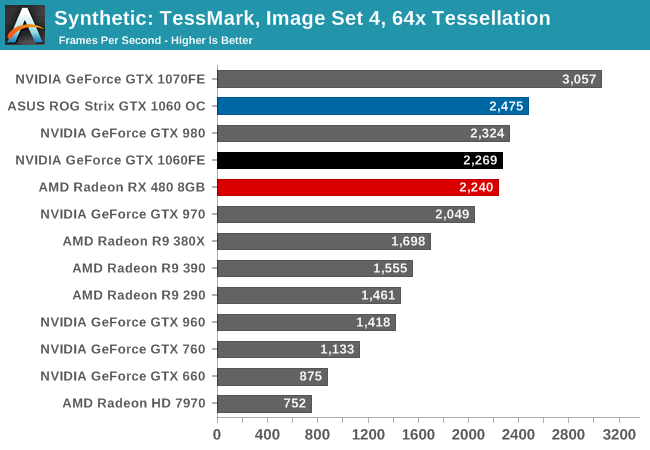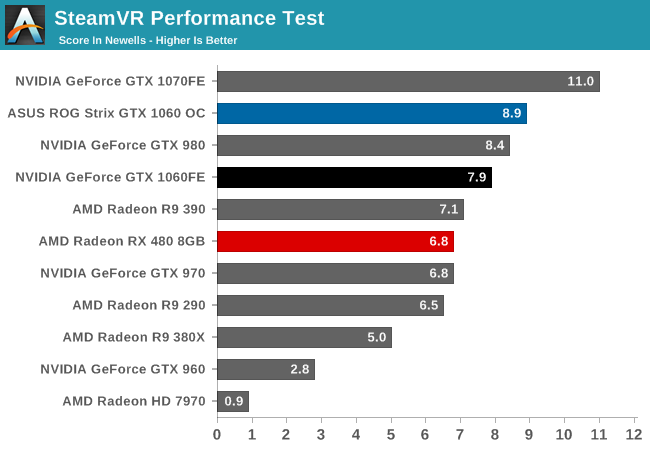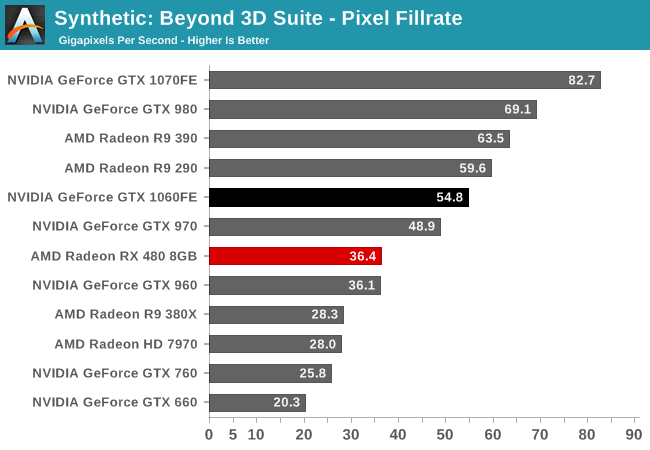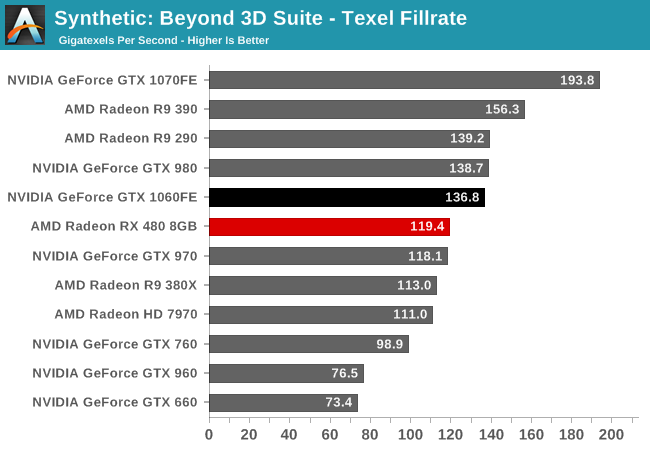The GeForce GTX 1060 Founders Edition & ASUS Strix GTX 1060 Review
by Ryan Smith on August 5, 2016 2:00 PM ESTSynthetics
As always we’ll also take a quick look at synthetic performance. While GTX 1060 is of course a cut down Pascal architecture part, how it has been cut down is interesting. Compared to GP104, GP106 has half the SMs and GPCs, but 3/4 the ROPs, which may prove to have an impact.

Starting off with tessellation performance, we find the GTX 1060 coming in just behind the GTX 980, showing that NVIDIA’s performance estimates generally apply not only to games, but synthetic tests as well. But perhaps more interesting is the fact that the card is neck-and-neck with the Radeon RX 480. NVIDIA has traditionally enjoyed a sizable geometry performance lead over AMD cards, but it looks like those days have come to a close.
Up next, we have SteamVR’s Performance Test. While this test is based on the latest version of Valve’s Source engine, the test itself is purely synthetic, designed to test the suitability of systems for VR, making it our sole VR-focused test at this time. It should be noted that the results in this test are not linear, and furthermore the score is capped at 11. Of particular note, cards that fail to reach GTX 970/R9 290 levels fall off of a cliff rather quickly. So test results should be interpreted a little differently.

As NVIDIA’s now entry-level VR card, GTX 1060 looks very good in the Steam VR test. A score of 7.9 Newells means that it’s comfortably above the 6.x range generally required, and it also means the GTX 1060 is comfortably ahead of the RX 480 in this scenario.
Finally, for looking at texel and pixel fillrate, we have the Beyond3D Test Suite. This test offers a slew of additional tests – many of which use behind the scenes or in our earlier architectural analysis – but for now we’ll stick to simple pixel and texel fillrates.

Starting with the pixel fillrate, we can see the impact of GTX 1060’s slightly more unusual ROP and GPC arrangement when it’s compared to the GTX 980. At 54.8 GPixels/second, GTX 1060 trails GTX 980 significantly. The card not only has fewer ROPs, but it has half of the rasterizer throughput (32 pixels/clock) as GTX 980. As we’ve seen in our gaming benchmarks the real-world impact isn’t nearly as great as what happens under these synthetic tests, but it helps to explain why sometimes GTX 1060 is tied with GTX 980, and other times it’s several percent behind. If nothing else, at an architectural level this is what makes GTX 1060 a better 1080p card than a 1440p card.

As for texel throughput, things are right where we expect them. GTX 1060 is virtually tied with GTX 980, and while it’s ahead of RX 480 in the process, it’s not by a massive amount.










189 Comments
View All Comments
Leozn01 - Wednesday, August 10, 2016 - link
Why do you guys no longer include Sony Vegas Pro in your GPU reviews?Tech-Curious - Wednesday, August 10, 2016 - link
I've been watching the RX 480 and GTX 1060 on Newegg since about two days after the former's launch. In that time, I have seen the reference 8gb 480 flash in and out of stock 2-3 times.The only 480 that was consistently available was priced waaay over the MSRP (@ $300+, the one I can find right now is at $400). 4GB models, as far as I can tell, have been nonexistent. Most importantly for me, there has been no hint of an AiB-partner board available at a decent price.
By contrast, I've seen 1060s flash in and out of stock several times in the comparatively shorter period since the 1060 launch, many of them in the $250-260 range.
The kicker was when the 470 launched and all of a sudden there were a small army of overpriced third-party 470s occupying the market segment that 480's MSRP was supposed to cover.
So, reluctantly, I snapped up a $250 1060 to replace my aging 7850. I really wanted to buy an AMD card; I had been waiting for Polaris to launch for months -- but when you combine the 480's higher power consumption, its bad reference cooler, the initial PCI-power-delivery controversy, and the lack of stock/options for what has to be at least a month now, this is what happens.
Ryan's correct; neither company's exactly in a great spot with stock, but from a cheap seats it sure seems that nVidia executed better than AMD in the short term. Pity.
m16 - Sunday, August 14, 2016 - link
I personally love blower cards. They're the best for SLI in smaller cases, but here the only good thing about them is being able to put them in small cases to begin with because there's no SLI connector.Bummer, but I bet the cards are still flying off the shelves.
Gastec - Tuesday, August 16, 2016 - link
Are you joking me? A 215% increrase in performance over GTX 960 (in Rise of the Planet of the Tomb Raider Apes) !!! Something is fishy, I can't see the performance difference in the specs. A 50-55% increase OK,but more...smelly fishy fish.Dorothycar - Sunday, September 13, 2020 - link
https://failarmy.irvision.info/anvbdnx4kq-HZKg/the...">[img]https://i.ytimg.com/vi/9JuDGFaKR-E/hqdefault.jpg[/img]The https://failarmy.irvision.info/anvbdnx4kq-HZKg/the...">Top 100 Fails of the Year (2019)FailArmy
Tonyawrize - Wednesday, October 28, 2020 - link
https://azadsoz.rulosk.info/d-m-nin-n/loJ6pKqykpq3...">[img]https://i.ytimg.com/vi/4IGryQ0bTmg/hqdefault.jpg[/img]DГјЕџmЙ™nin Г¶n xЙ™tti yarД±ldД±. DayandД±rД±lmasa, https://azadsoz.rulosk.info/d-m-nin-n/loJ6pKqykpq3...">QarabaДџ tam azad olunacaq
YasminHef - Saturday, October 31, 2020 - link
https://movstudio.thmatch.info/2KhzaqO2rslodZk/s-r...">[img]https://i.ytimg.com/vi/uwB1BUyg8Dg/hqdefault.jpg[/img]สรุปเนื้аёаё«аёІ Speed เร็วกว่านรก - MOV https://movstudio.thmatch.info/2KhzaqO2rslodZk/s-r...">Studio
Estherbouts - Sunday, November 1, 2020 - link
https://wrestlechatter.mrcameras.info/roman-reigns...">[img]https://i.ytimg.com/vi/wpo4PEO6oj4/hqdefault.jpg[/img]Roman Reigns Winning Universal Title CONFIRMED, Jon Moxley #1 https://wrestlechatter.mrcameras.info/roman-reigns...">Superstar, Payback Match Card, Top 500
Marshalef - Monday, November 2, 2020 - link
https://apodrash.grgone.info/q99inqKpacVus2Q/me-k-...">[img]https://i.ytimg.com/vi/Gy0frp9a6R0/hqdefault.jpg[/img]ОњОµ ОєО¬О»ОµПѓО±ОЅ ПѓП„Ої Alpha https://apodrash.grgone.info/q99inqKpacVus2Q/me-k-...">(Happy Day 7:45 ПЂ.Ој)